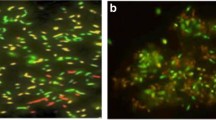Abstract
A model of a reactor-type biosensor based on the Rhodococcus erythropolis HL PM-1 was developed for amperometric detection of 2,4-dinitrophenol (2,4-DNP). The effects of the matrix material (agar and calcium alginate gels, ceramic support, and cellulose powder) on the biosensor signal concentration dependence, detection time, and biosensor stability were studied. In the case of bacterial cells immobilized on cellulose powder, the lower limit of 2,4-DNP detection was 20 μM and the time of single analysis, the biosensor recovery included, was 30–50 min. In the continuous detection mode, the biosensor response was maintained at a stable level without biosensor inactivation for ten days. The biosensor can be used as an element of a complex analytical system for detecting nitroaromatic compounds in samples.
Similar content being viewed by others
REFERENCES
Marvin-Sikkema, F.D. and de Bont, J.A.M., Appl. Microbiol. Biotechnol., 1994, vol. 42, no. 4, pp. 499-507.
Hallas, L.E. and Alexander, M., Appl. Environ. Microbiol., 1983, vol. 45, no. 4, pp. 1234-1241
Mel'nikov, N.N., Khimiya i tekhnologiya pestitsidov (Pesticides Chemistry and Technology), Moscow: Khimiya, 1974, p. 141.
Singirtsev, I.N., Krest'yaninov, V.Yu., and Korzhenevich, V.I., Prikl. Biokhim. Mikrobiol., 1994, vol. 30, no. 2, pp. 250-254.
Lenke, H., Pieper, D.H., Bruhn, C., and Knackmuss, H.-J., Appl. Environ. Microbiol., 1992, vol. 58, no. 9, pp. 2928-2932.
Emelianova, E.V. and Reshetilov, A.N., Proc. Biochem., 2002, vol. 37, no. 4, pp. 683-692.
Nomura, Y., Ikebukuro, K., Yokoyama, K., et al., Anal. Lett., 1994, vol. 27, no. 35, pp. 3095-3108.
Reshetilov, A.N., Iliasov, P.V., Knackmuss, H.-J., and Boronin, A.M., Anal. Lett., 2000, vol. 33, no. 1, pp. 29-41.
Lenke, H. and Knackmuss, H.-J., Appl. Environ. Microbiol., 1992, vol. 58, no. 9, pp. 2933-2937.
Lenke, H., Pieper, D.H., Bruhn, C., and Knackmuss, H.-J., Appl. Environ. Microbiol., 1992, vol. 58, no. 9, pp. 2928-2932.
Bruhn, C., Lenke, H., and Knackmuss, H.-J., Appl. Environ. Microbiol., 1987, vol. 53, no. 1, pp. 208-210.
Immobilized Cells and Enzymes, A Practical Approach, Woodward, J., Ed., Great Britain, Oxford, IRL, 1985. Translated under the title Immobilizovannye kletki i fermenty. Metody, Moscow: Mir, 1988.
Novikov, Yu.V., Lastochkina, K.O., and Boldina, Z.N., Metody issledovaniya kachestva vody vodoemov (Quality of Natural Water, A Practical Approach), Moscow: Meditsina, 1990, pp. 80-82.
Author information
Authors and Affiliations
Rights and permissions
About this article
Cite this article
Kitova, A.E., Kuvichkina, T.N., Il'yasov, P.V. et al. A Reactor-Type Biosensor Based on Rhodococcus erythropolis HL PM-1 Cells for Detecting 2,4-Dinitrophenol. Applied Biochemistry and Microbiology 38, 500–505 (2002). https://doi.org/10.1023/A:1019989023130
Issue Date:
DOI: https://doi.org/10.1023/A:1019989023130




